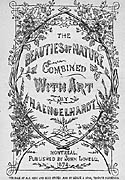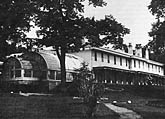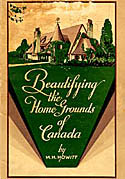Introduction
Planting the Seeds
Cultivating the Garden
Second-Generation Gardening
Landscape Architecture
Railway Station Gardening
Gardening in the Schools
The Cultivators
Reaping the Harvest
Bibliography
Photos by Beth Powning
Other Gardening Sites
Acknowledgements |
Cultivating the Garden
Landscape Architecture
Landscape architecture, the formal planning, design and management of private and public landscapes, began in the late 19th century in Canada, and first involved, for the most part, the private estates of the wealthy. Early in the new century, as part of the national movement to beautify the nation, landscape architects such as Frederick G. Todd of Montreal were commissioned to prepare plans for public spaces, such as the Plains of Abraham, the National Capital, and parks and cities across the country.
Writing in Belleville, where he was a landscape gardener with extensive expertise in designing cemeteries (he designed the Belleville Cemetery, Union Cemetery in Port Hope and Mount Pleasant Cemetery in Toronto), Heinrich Engelhardt produced the first Canadian book on landscape gardening.
"It is the object of the art of landscape gardening not merely to please the eye, but to improve the taste, and to excite the various affections and passions of the mind to a love of the beautiful." |
 |
Engelhardt, H.A.
The Beauties of Nature Combined with Art.
Montreal: Lovell, 1872, p. 11. |

| France Gagnon-Pratte outlines the various, elaborate styles of houses and grounds that were established in Quebec during the 19th century: the palladian with its formal entrances and gardens, the neo-classical with its trellises and ornamental friezes, the picturesque with its large park-like gardens, and the Victorian with luxurious greenhouses producing flowers and fresh vegetables all winter long. |

|
Gagnon-Pratte, France.
L'Architecture et la nature á Québec au dix-neuvième siècle: Les Villas.
Québec: Musée du Québec, 1980. |
| Frederick G. Todd, working in the early decades of the 20th century, created park and garden designs for all regions of the country. He drew up the first plan for the Capital in 1903. This recently published collection gives a wide-ranging sample of garden writers throughout Canada's history. |
von Baeyer, Edwinna and Pleasance Crawford, eds.
Garden Voices: Two Centuries of Canadian Garden Writing.
Toronto: Random, 1995. |
| In 1930, the Canadian Horticultural Council initiated what was described as a Dominion-wide campaign to beautify Canada by planning and planting public and private grounds with ornamental trees and shrubs and flowering plants. The Council and the Department of Agriculture issued this pamphlet as a guide. |
 |
Howitt, M.H.
Beautifying the Home Grounds of Canada.
Ottawa: Department of Agriculture, 1930. |
|
